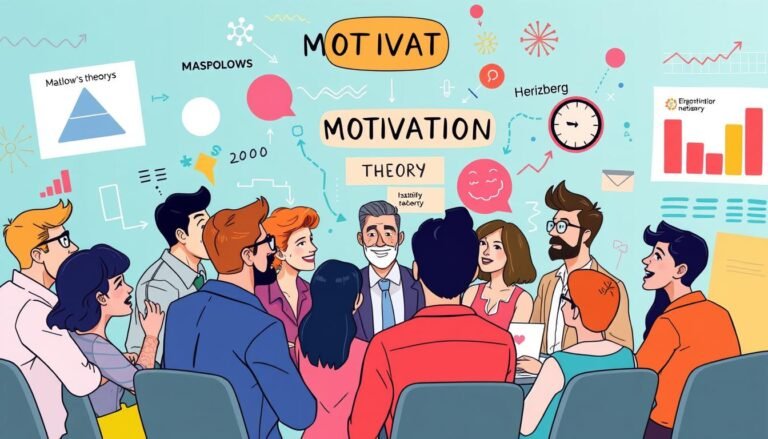The Science Behind Goal Setting: Organizational Psychology Insights for Leaders
Ever wondered why some leaders succeed while others don’t? The secret might be in goal setting. This powerful tool, based on organizational psychology, changes how leaders plan and set targets.
Goal setting is not just writing down dreams. It’s a strategic way to map out success for both people and groups. Studies show that skilled leaders can greatly improve their team’s drive, work quality, and success.
Let’s explore the exciting world of goal setting psychology. We’ll see how it can change leadership strategies. We’ll look at the SMART framework and the latest science on goal setting. These insights can make goal setting a key tool for leaders.
Key Takeaways
- Goal setting is key for motivation and success in life and work.
- The SMART framework (Specific, Measurable, Achievable, Realistic, Time-bound) makes goals more effective.
- Big goals lead to better work and results.
- Goal setting changes our brains, creating new habits and stronger connections.
- Good goal setting means planning, finding resources, being accountable, and using rewards and feedback.
- Leaders who get goal setting right can really boost their team’s motivation and performance.
Understanding Goal Setting in Psychology
Goal setting is a powerful tool for personal growth and achievement. It’s a key part of vision mapping and personal growth strategies. In psychology, it means creating clear plans to guide behavior and achieve desired outcomes.
Defining Goal Setting
Goal setting involves identifying specific objectives and creating a roadmap to reach them. It’s essential for milestone setting, helping individuals focus and measure progress. Research shows setting clear goals can boost performance by up to 25%.
The ABC of Goals
The ABC framework helps create effective goals:
- Achievable: Goals should be realistic and attainable
- Believable: You must have confidence in your ability to reach the goal
- Committed: Dedication to the goal is crucial for success
SMART and SMARTER Goals
SMART goals are a popular framework for effective goal setting:
| SMART Criteria | Description |
|---|---|
| Specific | Clear and well-defined |
| Measurable | Quantifiable progress |
| Attainable | Realistic and achievable |
| Relevant | Aligned with overall objectives |
| Time-bound | Set deadline for completion |
SMARTER goals add two more elements: Evaluative (regularly assess progress) and Rewarding (celebrate achievements). Studies show using SMART criteria can increase goal achievement by 20%.
By understanding these goal-setting principles, you can create a more effective personal growth strategy. This will improve your chances of success in various aspects of life.
The Psychology of Goal Setting
Goal setting is key to how we see ourselves and life. It links to finding our life purpose and building a success mindset. Those who set goals see hurdles as temporary, not huge barriers.
Setting goals is more than just making a list. It’s about creating a detailed plan that fits your values and reality. Successful goal-setters make detailed plans, use available resources, and stay accountable.
Studies show goal setting boosts both inner and outer motivation. It’s essential for athletes and business people. Aligning goals with personal values leads to more satisfaction and success.
“Goals are the fuel in the furnace of achievement.” – Brian Tracy
Recent studies have given us new insights into goal setting:
- 92% of New Year’s resolutions in the United States fail by January 15.
- Target goals aligned with goal setting theory principles typically yield a 90% success rate.
- The SMART (Specific, Measurable, Achievable, Realistic, Time-bound) framework is crucial for goal success.
Understanding goal setting psychology can greatly improve achieving personal and professional goals. It’s vital for aligning with life purpose and building a success mindset.
| Goal Type | Success Rate | Key Factor |
|---|---|---|
| New Year’s Resolutions | 8% | Lack of planning |
| Theory-aligned Goals | 90% | Structured approach |
| SMART Goals | High | Clear framework |
Goal Setting Theory: Locke’s Perspective
Dr. Edwin A. Locke’s goal-setting theory, published in 1968, explores the connection between planning and motivation. This research has greatly influenced how we view goal setting in organizational psychology.
Five Goal-Setting Principles
Locke’s theory is based on five main principles:
- Clarity: Clear goals lead to better performance
- Challenge: Ambitious goals boost motivation
- Commitment: Aligning employees with goals is key
- Feedback: Regular checks help achieve success
- Complexity: Finding the right balance is crucial
Four Major Components of Goals
Effective goals have four essential parts:
- Difficulty: Goals should be challenging but reachable
- Specificity: Goals must be measurable and have deadlines
- Reward: Clear rewards for achieving goals
- Efficacy: Believing in one’s ability to succeed
Avoiding Optimism Bias
It’s important to avoid optimism bias when setting goals. Studies show that 92% of New Year’s resolutions fail by January 15th. Locke suggests analyzing goals carefully to ensure they are realistic. Writing down goals can increase success by 50%, showing the value of a structured approach.
“Goals have an energizing function; the higher the goal, the greater the effort invested.” – Locke & Latham, 2002
By following these principles and avoiding common mistakes, leaders can create effective plans. These plans can drive success in organizations.
The Impact of Goal Setting on Leadership
Goal setting is key for effective leadership. It guides an organization’s direction and motivates teams to excel. Leaders who excel in goal setting set a clear path to success, inspiring their teams to reach new heights.
Vision mapping is vital in this process. It outlines a compelling future state, creating a gap between the current and desired outcomes. This gap motivates employees to work hard to bridge it.
Having a personal growth strategy is crucial for leaders and team members. When goals align with the company’s objectives, employees feel more connected and invested. This alignment boosts performance and direction.
Success mindset cultivation is also key in goal setting. Encouraging employees to aim for ambitious yet achievable goals promotes a culture of improvement and innovation. This mindset shift can lead to outstanding results, as seen in companies like Google, where 50% of new products come from dedicated goal-setting time.
| Impact of Goal Setting | Statistics |
|---|---|
| Employee Efficiency Increase | 40% |
| Employee Engagement with Autonomous Goal Setting | 85% |
| Success Rate Increase for Ambitious Goals | 30% |
| Increase in Morale and Teamwork | 25% |
Effective goal setting empowers leaders to guide their teams towards excellence. By setting clear objectives, promoting personal growth, and fostering a success mindset, leaders can unlock their organization’s full potential. This leads to remarkable achievements.
Transformational Leadership and Goal Setting
Transformational leadership is key in planning and setting targets. Leaders who use this style motivate their teams to do more and reach goals. We’ll look at two models that show how this works.
Bass’s Transformational Leadership Model
Bass’s model has four main parts:
- Idealized influence
- Inspirational motivation
- Intellectual stimulation
- Individualized consideration
These parts help make a plan for success for both leaders and followers. A study shows that these leaders change how followers see goals. This affects job happiness and how proactive they are.
Conger and Kanungo’s Three-Stage Model
This model offers a simple way to lead:
- Look at the current situation
- Set and share goals
- Build trust and show how to reach goals
This method fits well with planning and making a clear path to success. Research proves that clear, yet challenging goals boost performance. They focus effort and improve results.
| Leadership Style | Focus | Outcome |
|---|---|---|
| Transformational | Inspiration and motivation | Exceeding expectations |
| Transactional | Exchanges and rewards | Meeting set targets |
Transformational leadership is becoming more common as companies face fast changes in the digital world. By using these models, leaders can lead their teams well. They help in finding targets and making strong plans for success.
Goal Setting in Organizational Psychology
Goal setting is key in organizational psychology. It boosts employee performance and personal growth. It also makes sure everyone’s work matches the company’s goals. Let’s see how goal setting affects the workplace and helps organizations succeed.
Applications in the Workplace
In the workplace, goal setting is a strong tool. It helps set milestones and aligns personal goals with company objectives. This method increases productivity and helps employees grow.
- Increases productivity by 11% to 25%
- Enhances employee motivation and engagement
- Facilitates better task coordination and team collaboration
Performance Management and Goal Setting
Performance management systems rely on goal setting. They make setting milestones a regular part of work. This creates a culture of improvement and achievement.
This approach helps employees match their goals with the company’s. It’s a win-win situation.
| Goal Setting Element | Impact on Performance |
|---|---|
| Clarity | Reduces ambiguity, increases focus |
| Challenge | Boosts motivation and effort |
| Commitment | Enhances persistence and goal attainment |
| Feedback | Facilitates progress tracking and adjustment |
| Task Complexity | Encourages strategy development and skill growth |
By using these elements, organizations can build a strong goal-setting framework. This framework supports both personal growth and company success. It drives performance and helps employees feel a sense of purpose and achievement.
The Neuroscience of Goal Setting
Goal setting is more than just a tool for getting things done. It changes our brains. Vision mapping and personal growth strategies work with our brain’s reward system. This system is key for motivation and making decisions.
When we set SMART goals, we use our brain’s command center. This area is in charge of chasing our goals. It’s like a headquarters for our brain’s efforts.
The brain’s ability to change and adapt is vital for success. As we work towards our goals, our brain’s pathways get stronger. This makes it easier to reach our goals in the future. It’s a cycle of growth and achievement.
The reticular activating system (RAS) is a key part of goal setting. It filters what we notice. By setting clear goals, we tell our RAS to pay attention to important things we might miss.
| Brain Area | Function in Goal Setting | Impact on Success |
|---|---|---|
| Prefrontal Cortex | Decision-making, goal pursuit | Enhances focus on objectives |
| Reward System | Motivation, reinforcement | Increases drive to achieve goals |
| RAS | Attention filtering | Improves awareness of opportunities |
Knowing how our brains work can help us set better goals. By matching our goals with our brain’s natural ways, we can grow more effectively. This builds a strong success mindset.
Goal Setting and Self-Regulation
Goal setting is key to self-regulation. It helps people reach their goals. This involves planning and identifying targets, creating a roadmap to success.
Self-Regulatory Thought Processes
Self-regulation in goal pursuit has three main thought processes:
- Mentally contrasting the desired future with reality
- Dwelling on negative aspects of current reality
- Indulging in the desired future
These steps help people adapt to changes and keep their focus. Research shows specific goals are better than vague ones like “try hard.”
The Role of Self-Efficacy
Believing in oneself is crucial for goal setting. It affects:
- Choice of activities
- Effort expenditure
- Persistence in learning tasks
Learning goals, which aim to acquire skills or knowledge, boost self-efficacy more than performance goals. This is key for a strong achievement roadmap.
| Goal Type | Effect on Self-Regulation | Effect on Motivation |
|---|---|---|
| Specific Goals | Enhanced | High |
| Proximal Goals | Better | Higher |
| Moderately Difficult Goals | Optimal | Best |
| Self-Set Goals | Enhanced | Increased |
Understanding these principles helps leaders plan better. They can guide their teams to achieve their goals effectively.
Goal Setting Strategies for Leaders
Leaders are key in guiding their teams to success. They use goal setting as a main strategy. By setting smart milestones, leaders create a path for their team’s success. This builds a culture of growth and achievement.
Aligning individual goals with the company’s vision is a powerful method. It gives team members a sense of purpose. It shows how their work helps the company grow. Leaders should involve their team in setting goals. This boosts motivation and performance.
Creating a self-actualization plan for each team member is also effective. This involves:
- Identifying individual strengths and areas for growth
- Setting challenging yet attainable goals
- Providing regular feedback and support
- Adjusting goals as needed based on progress and changing circumstances
Leaders should also focus on aligning goals with personal values. This leads to higher job satisfaction and keeps employees. In fact, 94% of employees want to stay where they can grow professionally.
“The key to successful leadership today is influence, not authority.” – Ken Blanchard
To make goal setting work, leaders need a feedback loop. This allows for quick adjustments. Breaking big goals into smaller ones also helps. It keeps the team motivated and on track.
Measuring the Effectiveness of Goal Setting
Tracking progress is key to success. Leaders use various tools to measure goal-setting effectiveness. These tools help assess growth, spot areas for improvement, and show the value of goal-setting efforts.
Key Performance Indicators
Key Performance Indicators (KPIs) are vital for vision mapping. They offer clear metrics to gauge success. For example, customer churn rate helps track customer retention. The formula is: customers who don’t repeat a purchase ÷ total customers. A low rate indicates effective strategies.
Goal Attainment Scaling
Goal Attainment Scaling is a powerful personal growth strategy. It measures how well goals are met during an intervention. This method assigns scores to different levels of goal achievement. It’s useful for both individual and team goals.
Success mindset cultivation involves regular progress checks. Use these tools to stay on track:
- Set SMART goals (Specific, Measurable, Achievable, Relevant, Time-bound)
- Break long-term goals into short-term milestones
- Use both qualitative and quantitative measures
- Adjust goals based on feedback and results
Remember, effective goal measurement leads to better outcomes. It helps leaders make informed decisions and keeps teams motivated. By using these tools, you can ensure your goals drive real progress and success.
Conclusion
Goal setting is key in organizational psychology and leadership. It’s not just about setting targets. It’s about creating a roadmap to success for individuals and teams.
Effective goal planning uses psychological principles and models to boost performance. This approach helps teams work better together.
The power of goal setting is in boosting motivation and self-regulation. By focusing on targets, organizations can improve continuously. Leaders who set goals well empower their teams to reach their best.
The SMART model is useful but has its limits in personal goal setting. It’s important to know the purpose of each goal and set realistic times. A clear goal is a goal that can be achieved.
By focusing on the right metrics, leaders can keep their goal-setting strategies effective. This is crucial in changing work environments.
Goal setting is more than a tool for management. It’s a path to growth for both organizations and individuals. As we move forward, new ideas will help us understand goal setting better.
Source Links
- The Science & Psychology Of Goal-Setting 101
- Goal Setting: Science and Psychology
- The Neuroscience of Goal-Setting and Its Impact on Your Culture – Culture Partners
- What is Goal Setting and How to Do it Well
- The Psychology of Goal Setting: Lessons in Success and Failure
- Goal-Setting – CALE Learning Enhancement
- The Neuroscience of Goals and Behavior Change
- Achieve Your Goals Using Psychology | Psychological Health Care, Perth
- What is Locke’s Goal Setting Theory of Motivation?
- Locke’s Goal-Setting Theory of Motivation
- How Leaders Use The Power Of Goal Alignment
- Why Goal Setting Is Important For Leaders
- The Path Is the Goal: How Transformational Leaders Enhance Followers’ Job Attitudes and Proactive Behavior
- What is Transformational Leadership and Why is it Effective? | UMass Global
- Organizational & Industrial Psychology in the 21st Century—Goal-Setting Theory and Performance Management A Systematic Literature Review
- Microsoft Word – 1-Organizational Psychology Revisited. Goal Setting Theory in Recent Years A Systematic Literature Review
- The Neuroscience of Goal Setting: Designing Performance Management Systems for Success
- The Neuroscience Behind Setting Goals
- Self-regulation through goal setting
- Leadership Goal Setting: Strategies for Success in 2024
- Effective Leadership and Goal-Setting: A Comprehensive Guide
- The mechanism of goal-setting participation’s impact on employees’ proactive behavior, moderated mediation role of power distance
- How Setting Effective Goals Can Improve Organizational Performance
- 7 Steps For A Successful Goal-Setting Process
- GOAL SETTING: PART 4 – CONCLUSION
- The Power of Goal Setting







